BA30590E - Managing People and Systems: Motivation Theories Analysis
VerifiedAdded on 2022/12/22
|8
|2215
|81
Report
AI Summary
This report explores various motivation theories and their application in the modern workplace, emphasizing the importance of managing people and systems for organizational success. It delves into theories such as Maslow's hierarchy of needs, Herzberg's two-factor theory, Vroom's expectancy theory, and others, illustrating how they can be utilized to enhance employee performance and create a positive work environment. The report highlights the significance of motivation in driving employee behavior, achieving organizational goals, and improving overall efficiency and productivity. It also discusses the practical implications of these theories, offering examples and guidelines for managers to effectively manage their teams and foster a motivated workforce. Furthermore, the report touches upon related concepts such as equity theory, goal-setting theory, and reinforcement theory, providing a comprehensive overview of the factors that influence employee motivation and contribute to effective people and system management.

Managing People and
System
System
Paraphrase This Document
Need a fresh take? Get an instant paraphrase of this document with our AI Paraphraser
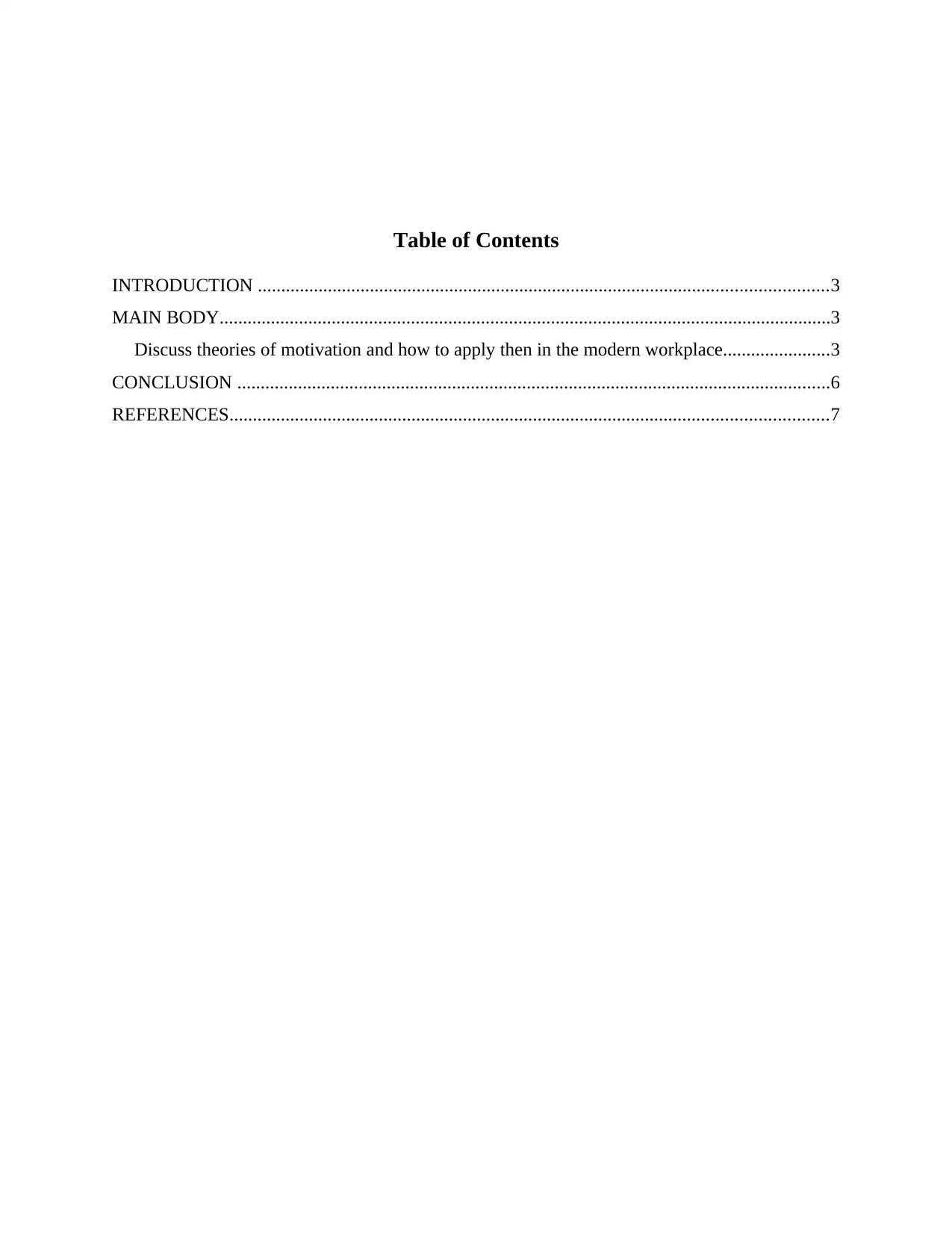
Table of Contents
INTRODUCTION ..........................................................................................................................3
MAIN BODY...................................................................................................................................3
Discuss theories of motivation and how to apply then in the modern workplace.......................3
CONCLUSION ...............................................................................................................................6
REFERENCES................................................................................................................................7
INTRODUCTION ..........................................................................................................................3
MAIN BODY...................................................................................................................................3
Discuss theories of motivation and how to apply then in the modern workplace.......................3
CONCLUSION ...............................................................................................................................6
REFERENCES................................................................................................................................7
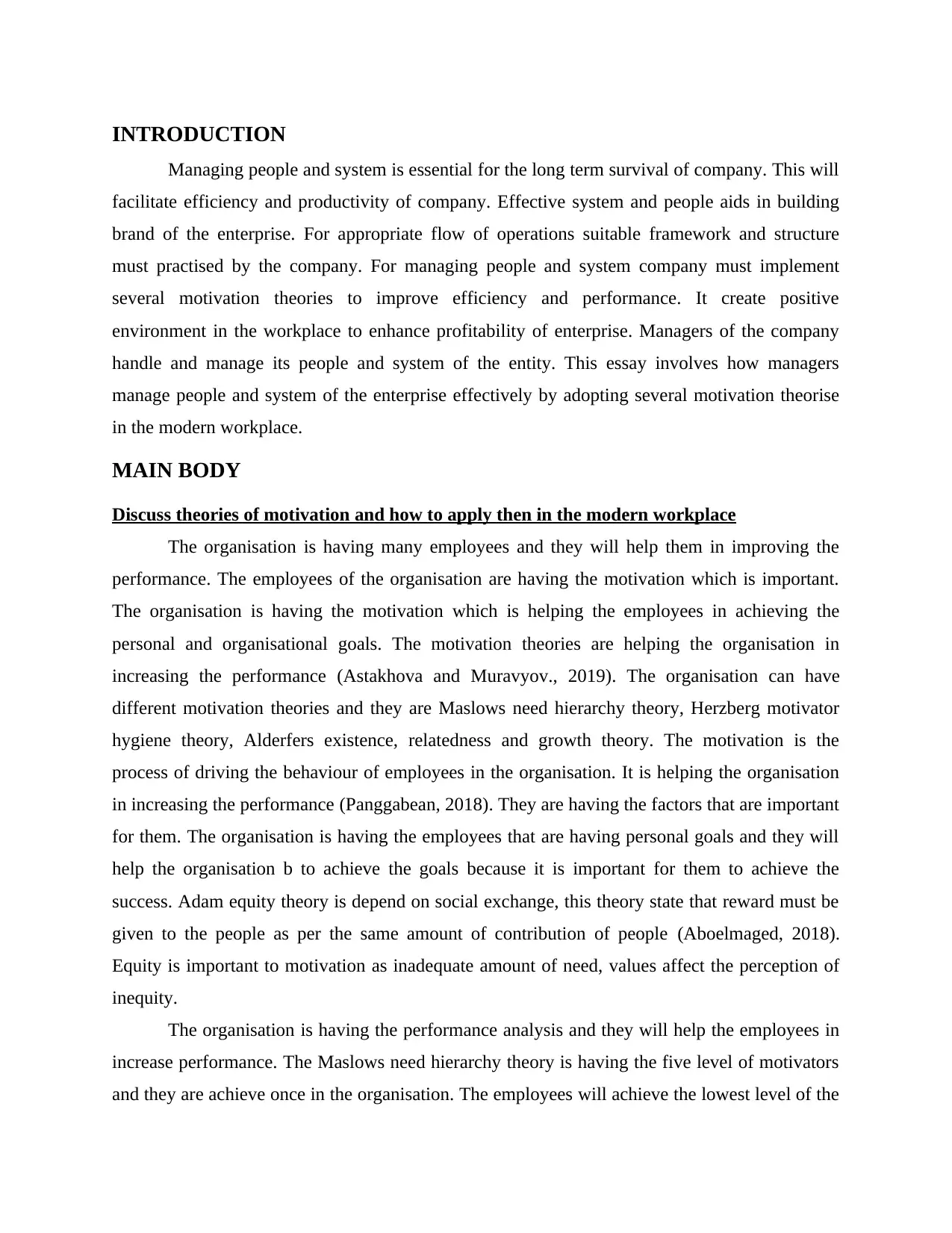
INTRODUCTION
Managing people and system is essential for the long term survival of company. This will
facilitate efficiency and productivity of company. Effective system and people aids in building
brand of the enterprise. For appropriate flow of operations suitable framework and structure
must practised by the company. For managing people and system company must implement
several motivation theories to improve efficiency and performance. It create positive
environment in the workplace to enhance profitability of enterprise. Managers of the company
handle and manage its people and system of the entity. This essay involves how managers
manage people and system of the enterprise effectively by adopting several motivation theorise
in the modern workplace.
MAIN BODY
Discuss theories of motivation and how to apply then in the modern workplace
The organisation is having many employees and they will help them in improving the
performance. The employees of the organisation are having the motivation which is important.
The organisation is having the motivation which is helping the employees in achieving the
personal and organisational goals. The motivation theories are helping the organisation in
increasing the performance (Astakhova and Muravyov., 2019). The organisation can have
different motivation theories and they are Maslows need hierarchy theory, Herzberg motivator
hygiene theory, Alderfers existence, relatedness and growth theory. The motivation is the
process of driving the behaviour of employees in the organisation. It is helping the organisation
in increasing the performance (Panggabean, 2018). They are having the factors that are important
for them. The organisation is having the employees that are having personal goals and they will
help the organisation b to achieve the goals because it is important for them to achieve the
success. Adam equity theory is depend on social exchange, this theory state that reward must be
given to the people as per the same amount of contribution of people (Aboelmaged, 2018).
Equity is important to motivation as inadequate amount of need, values affect the perception of
inequity.
The organisation is having the performance analysis and they will help the employees in
increase performance. The Maslows need hierarchy theory is having the five level of motivators
and they are achieve once in the organisation. The employees will achieve the lowest level of the
Managing people and system is essential for the long term survival of company. This will
facilitate efficiency and productivity of company. Effective system and people aids in building
brand of the enterprise. For appropriate flow of operations suitable framework and structure
must practised by the company. For managing people and system company must implement
several motivation theories to improve efficiency and performance. It create positive
environment in the workplace to enhance profitability of enterprise. Managers of the company
handle and manage its people and system of the entity. This essay involves how managers
manage people and system of the enterprise effectively by adopting several motivation theorise
in the modern workplace.
MAIN BODY
Discuss theories of motivation and how to apply then in the modern workplace
The organisation is having many employees and they will help them in improving the
performance. The employees of the organisation are having the motivation which is important.
The organisation is having the motivation which is helping the employees in achieving the
personal and organisational goals. The motivation theories are helping the organisation in
increasing the performance (Astakhova and Muravyov., 2019). The organisation can have
different motivation theories and they are Maslows need hierarchy theory, Herzberg motivator
hygiene theory, Alderfers existence, relatedness and growth theory. The motivation is the
process of driving the behaviour of employees in the organisation. It is helping the organisation
in increasing the performance (Panggabean, 2018). They are having the factors that are important
for them. The organisation is having the employees that are having personal goals and they will
help the organisation b to achieve the goals because it is important for them to achieve the
success. Adam equity theory is depend on social exchange, this theory state that reward must be
given to the people as per the same amount of contribution of people (Aboelmaged, 2018).
Equity is important to motivation as inadequate amount of need, values affect the perception of
inequity.
The organisation is having the performance analysis and they will help the employees in
increase performance. The Maslows need hierarchy theory is having the five level of motivators
and they are achieve once in the organisation. The employees will achieve the lowest level of the
⊘ This is a preview!⊘
Do you want full access?
Subscribe today to unlock all pages.

Trusted by 1+ million students worldwide
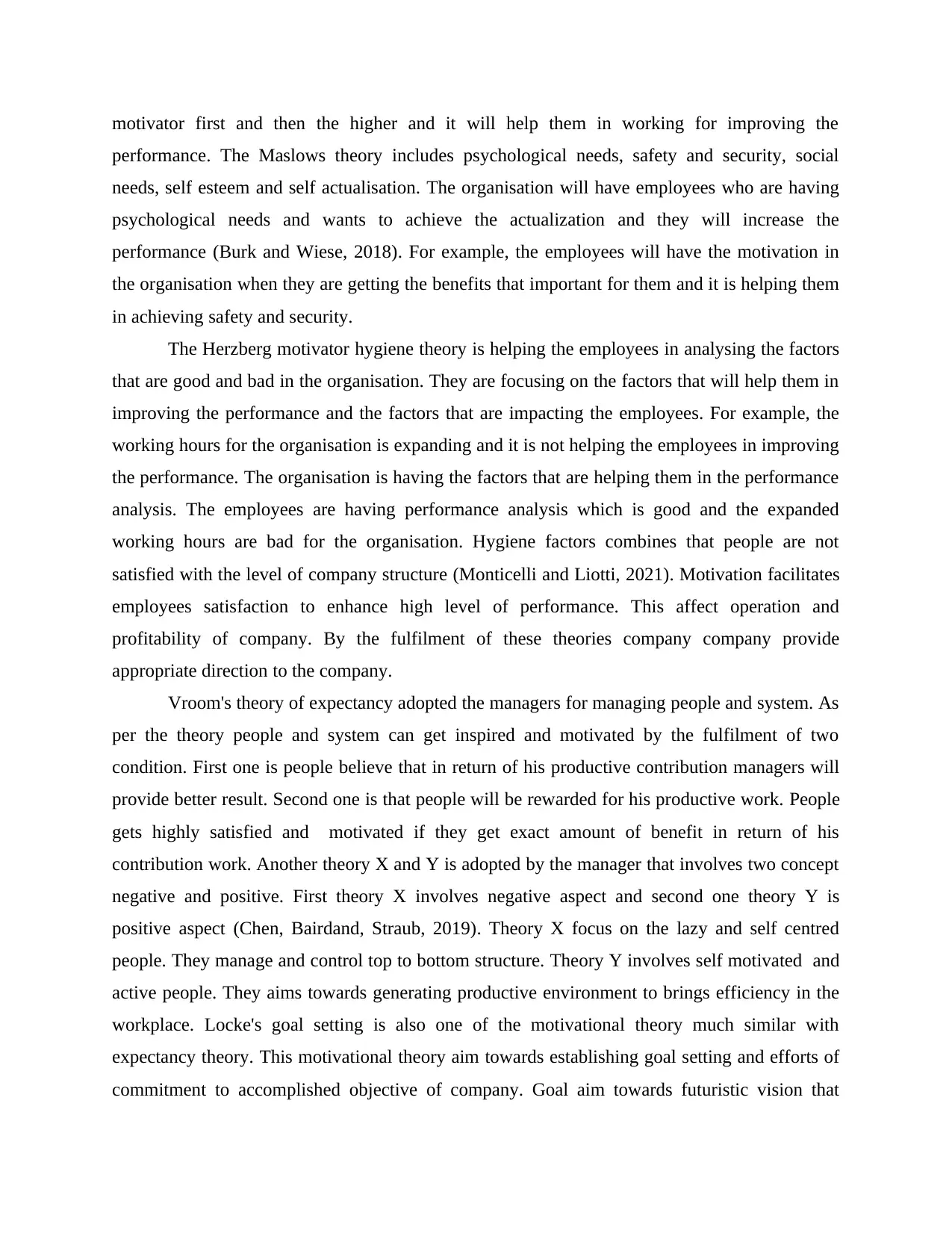
motivator first and then the higher and it will help them in working for improving the
performance. The Maslows theory includes psychological needs, safety and security, social
needs, self esteem and self actualisation. The organisation will have employees who are having
psychological needs and wants to achieve the actualization and they will increase the
performance (Burk and Wiese, 2018). For example, the employees will have the motivation in
the organisation when they are getting the benefits that important for them and it is helping them
in achieving safety and security.
The Herzberg motivator hygiene theory is helping the employees in analysing the factors
that are good and bad in the organisation. They are focusing on the factors that will help them in
improving the performance and the factors that are impacting the employees. For example, the
working hours for the organisation is expanding and it is not helping the employees in improving
the performance. The organisation is having the factors that are helping them in the performance
analysis. The employees are having performance analysis which is good and the expanded
working hours are bad for the organisation. Hygiene factors combines that people are not
satisfied with the level of company structure (Monticelli and Liotti, 2021). Motivation facilitates
employees satisfaction to enhance high level of performance. This affect operation and
profitability of company. By the fulfilment of these theories company company provide
appropriate direction to the company.
Vroom's theory of expectancy adopted the managers for managing people and system. As
per the theory people and system can get inspired and motivated by the fulfilment of two
condition. First one is people believe that in return of his productive contribution managers will
provide better result. Second one is that people will be rewarded for his productive work. People
gets highly satisfied and motivated if they get exact amount of benefit in return of his
contribution work. Another theory X and Y is adopted by the manager that involves two concept
negative and positive. First theory X involves negative aspect and second one theory Y is
positive aspect (Chen, Bairdand, Straub, 2019). Theory X focus on the lazy and self centred
people. They manage and control top to bottom structure. Theory Y involves self motivated and
active people. They aims towards generating productive environment to brings efficiency in the
workplace. Locke's goal setting is also one of the motivational theory much similar with
expectancy theory. This motivational theory aim towards establishing goal setting and efforts of
commitment to accomplished objective of company. Goal aim towards futuristic vision that
performance. The Maslows theory includes psychological needs, safety and security, social
needs, self esteem and self actualisation. The organisation will have employees who are having
psychological needs and wants to achieve the actualization and they will increase the
performance (Burk and Wiese, 2018). For example, the employees will have the motivation in
the organisation when they are getting the benefits that important for them and it is helping them
in achieving safety and security.
The Herzberg motivator hygiene theory is helping the employees in analysing the factors
that are good and bad in the organisation. They are focusing on the factors that will help them in
improving the performance and the factors that are impacting the employees. For example, the
working hours for the organisation is expanding and it is not helping the employees in improving
the performance. The organisation is having the factors that are helping them in the performance
analysis. The employees are having performance analysis which is good and the expanded
working hours are bad for the organisation. Hygiene factors combines that people are not
satisfied with the level of company structure (Monticelli and Liotti, 2021). Motivation facilitates
employees satisfaction to enhance high level of performance. This affect operation and
profitability of company. By the fulfilment of these theories company company provide
appropriate direction to the company.
Vroom's theory of expectancy adopted the managers for managing people and system. As
per the theory people and system can get inspired and motivated by the fulfilment of two
condition. First one is people believe that in return of his productive contribution managers will
provide better result. Second one is that people will be rewarded for his productive work. People
gets highly satisfied and motivated if they get exact amount of benefit in return of his
contribution work. Another theory X and Y is adopted by the manager that involves two concept
negative and positive. First theory X involves negative aspect and second one theory Y is
positive aspect (Chen, Bairdand, Straub, 2019). Theory X focus on the lazy and self centred
people. They manage and control top to bottom structure. Theory Y involves self motivated and
active people. They aims towards generating productive environment to brings efficiency in the
workplace. Locke's goal setting is also one of the motivational theory much similar with
expectancy theory. This motivational theory aim towards establishing goal setting and efforts of
commitment to accomplished objective of company. Goal aim towards futuristic vision that
Paraphrase This Document
Need a fresh take? Get an instant paraphrase of this document with our AI Paraphraser
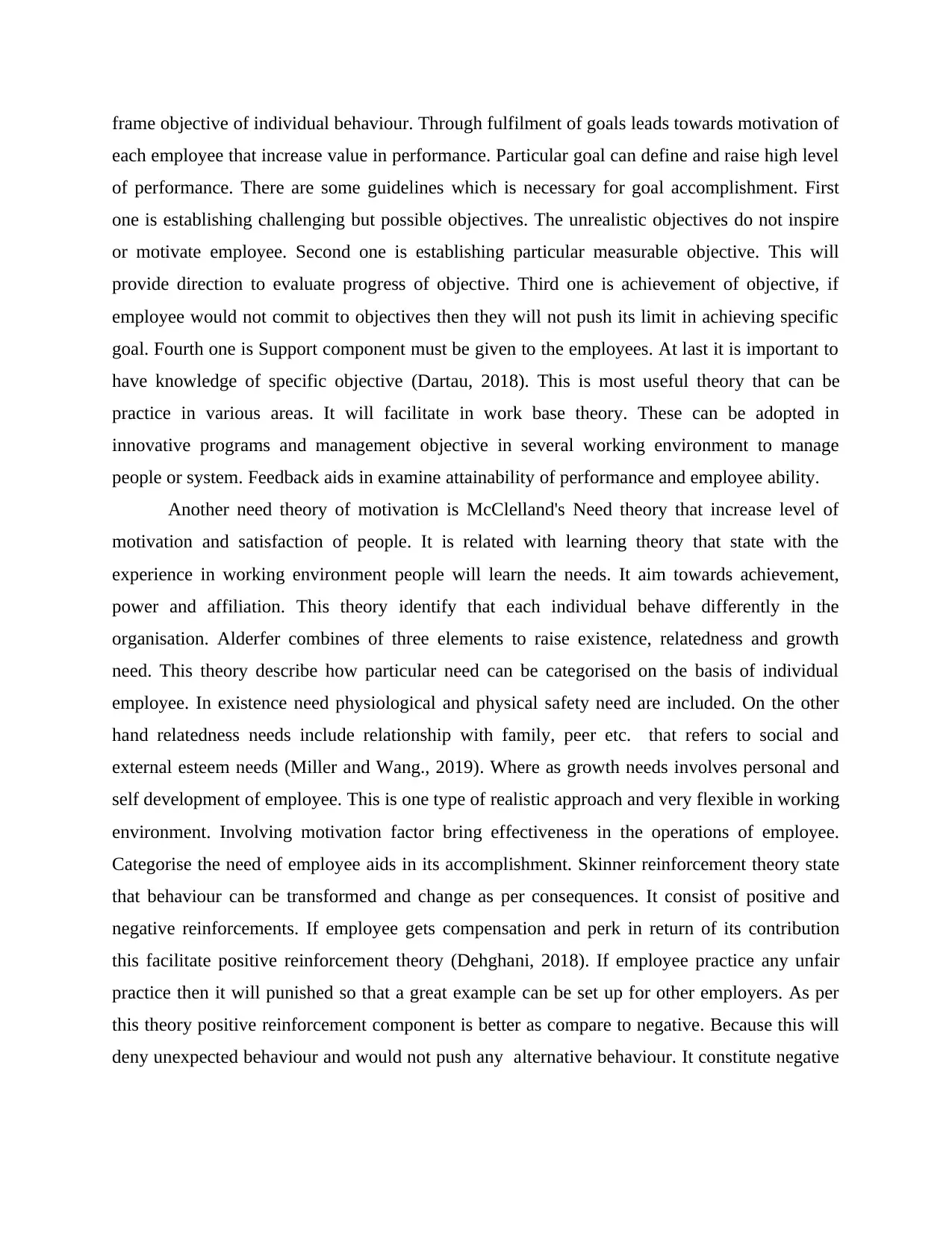
frame objective of individual behaviour. Through fulfilment of goals leads towards motivation of
each employee that increase value in performance. Particular goal can define and raise high level
of performance. There are some guidelines which is necessary for goal accomplishment. First
one is establishing challenging but possible objectives. The unrealistic objectives do not inspire
or motivate employee. Second one is establishing particular measurable objective. This will
provide direction to evaluate progress of objective. Third one is achievement of objective, if
employee would not commit to objectives then they will not push its limit in achieving specific
goal. Fourth one is Support component must be given to the employees. At last it is important to
have knowledge of specific objective (Dartau, 2018). This is most useful theory that can be
practice in various areas. It will facilitate in work base theory. These can be adopted in
innovative programs and management objective in several working environment to manage
people or system. Feedback aids in examine attainability of performance and employee ability.
Another need theory of motivation is McClelland's Need theory that increase level of
motivation and satisfaction of people. It is related with learning theory that state with the
experience in working environment people will learn the needs. It aim towards achievement,
power and affiliation. This theory identify that each individual behave differently in the
organisation. Alderfer combines of three elements to raise existence, relatedness and growth
need. This theory describe how particular need can be categorised on the basis of individual
employee. In existence need physiological and physical safety need are included. On the other
hand relatedness needs include relationship with family, peer etc. that refers to social and
external esteem needs (Miller and Wang., 2019). Where as growth needs involves personal and
self development of employee. This is one type of realistic approach and very flexible in working
environment. Involving motivation factor bring effectiveness in the operations of employee.
Categorise the need of employee aids in its accomplishment. Skinner reinforcement theory state
that behaviour can be transformed and change as per consequences. It consist of positive and
negative reinforcements. If employee gets compensation and perk in return of its contribution
this facilitate positive reinforcement theory (Dehghani, 2018). If employee practice any unfair
practice then it will punished so that a great example can be set up for other employers. As per
this theory positive reinforcement component is better as compare to negative. Because this will
deny unexpected behaviour and would not push any alternative behaviour. It constitute negative
each employee that increase value in performance. Particular goal can define and raise high level
of performance. There are some guidelines which is necessary for goal accomplishment. First
one is establishing challenging but possible objectives. The unrealistic objectives do not inspire
or motivate employee. Second one is establishing particular measurable objective. This will
provide direction to evaluate progress of objective. Third one is achievement of objective, if
employee would not commit to objectives then they will not push its limit in achieving specific
goal. Fourth one is Support component must be given to the employees. At last it is important to
have knowledge of specific objective (Dartau, 2018). This is most useful theory that can be
practice in various areas. It will facilitate in work base theory. These can be adopted in
innovative programs and management objective in several working environment to manage
people or system. Feedback aids in examine attainability of performance and employee ability.
Another need theory of motivation is McClelland's Need theory that increase level of
motivation and satisfaction of people. It is related with learning theory that state with the
experience in working environment people will learn the needs. It aim towards achievement,
power and affiliation. This theory identify that each individual behave differently in the
organisation. Alderfer combines of three elements to raise existence, relatedness and growth
need. This theory describe how particular need can be categorised on the basis of individual
employee. In existence need physiological and physical safety need are included. On the other
hand relatedness needs include relationship with family, peer etc. that refers to social and
external esteem needs (Miller and Wang., 2019). Where as growth needs involves personal and
self development of employee. This is one type of realistic approach and very flexible in working
environment. Involving motivation factor bring effectiveness in the operations of employee.
Categorise the need of employee aids in its accomplishment. Skinner reinforcement theory state
that behaviour can be transformed and change as per consequences. It consist of positive and
negative reinforcements. If employee gets compensation and perk in return of its contribution
this facilitate positive reinforcement theory (Dehghani, 2018). If employee practice any unfair
practice then it will punished so that a great example can be set up for other employers. As per
this theory positive reinforcement component is better as compare to negative. Because this will
deny unexpected behaviour and would not push any alternative behaviour. It constitute negative
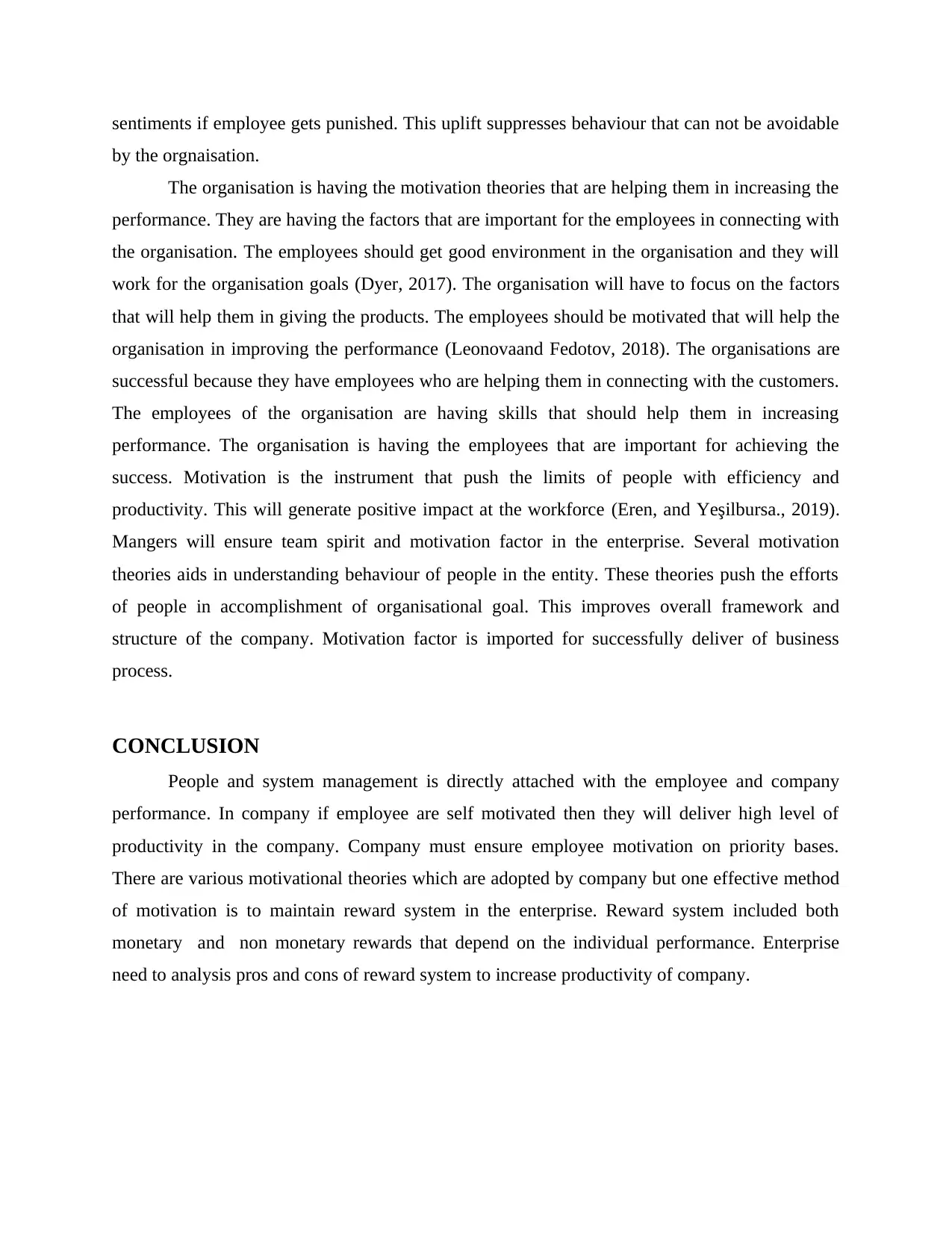
sentiments if employee gets punished. This uplift suppresses behaviour that can not be avoidable
by the orgnaisation.
The organisation is having the motivation theories that are helping them in increasing the
performance. They are having the factors that are important for the employees in connecting with
the organisation. The employees should get good environment in the organisation and they will
work for the organisation goals (Dyer, 2017). The organisation will have to focus on the factors
that will help them in giving the products. The employees should be motivated that will help the
organisation in improving the performance (Leonovaand Fedotov, 2018). The organisations are
successful because they have employees who are helping them in connecting with the customers.
The employees of the organisation are having skills that should help them in increasing
performance. The organisation is having the employees that are important for achieving the
success. Motivation is the instrument that push the limits of people with efficiency and
productivity. This will generate positive impact at the workforce (Eren, and Yeşilbursa., 2019).
Mangers will ensure team spirit and motivation factor in the enterprise. Several motivation
theories aids in understanding behaviour of people in the entity. These theories push the efforts
of people in accomplishment of organisational goal. This improves overall framework and
structure of the company. Motivation factor is imported for successfully deliver of business
process.
CONCLUSION
People and system management is directly attached with the employee and company
performance. In company if employee are self motivated then they will deliver high level of
productivity in the company. Company must ensure employee motivation on priority bases.
There are various motivational theories which are adopted by company but one effective method
of motivation is to maintain reward system in the enterprise. Reward system included both
monetary and non monetary rewards that depend on the individual performance. Enterprise
need to analysis pros and cons of reward system to increase productivity of company.
by the orgnaisation.
The organisation is having the motivation theories that are helping them in increasing the
performance. They are having the factors that are important for the employees in connecting with
the organisation. The employees should get good environment in the organisation and they will
work for the organisation goals (Dyer, 2017). The organisation will have to focus on the factors
that will help them in giving the products. The employees should be motivated that will help the
organisation in improving the performance (Leonovaand Fedotov, 2018). The organisations are
successful because they have employees who are helping them in connecting with the customers.
The employees of the organisation are having skills that should help them in increasing
performance. The organisation is having the employees that are important for achieving the
success. Motivation is the instrument that push the limits of people with efficiency and
productivity. This will generate positive impact at the workforce (Eren, and Yeşilbursa., 2019).
Mangers will ensure team spirit and motivation factor in the enterprise. Several motivation
theories aids in understanding behaviour of people in the entity. These theories push the efforts
of people in accomplishment of organisational goal. This improves overall framework and
structure of the company. Motivation factor is imported for successfully deliver of business
process.
CONCLUSION
People and system management is directly attached with the employee and company
performance. In company if employee are self motivated then they will deliver high level of
productivity in the company. Company must ensure employee motivation on priority bases.
There are various motivational theories which are adopted by company but one effective method
of motivation is to maintain reward system in the enterprise. Reward system included both
monetary and non monetary rewards that depend on the individual performance. Enterprise
need to analysis pros and cons of reward system to increase productivity of company.
⊘ This is a preview!⊘
Do you want full access?
Subscribe today to unlock all pages.

Trusted by 1+ million students worldwide
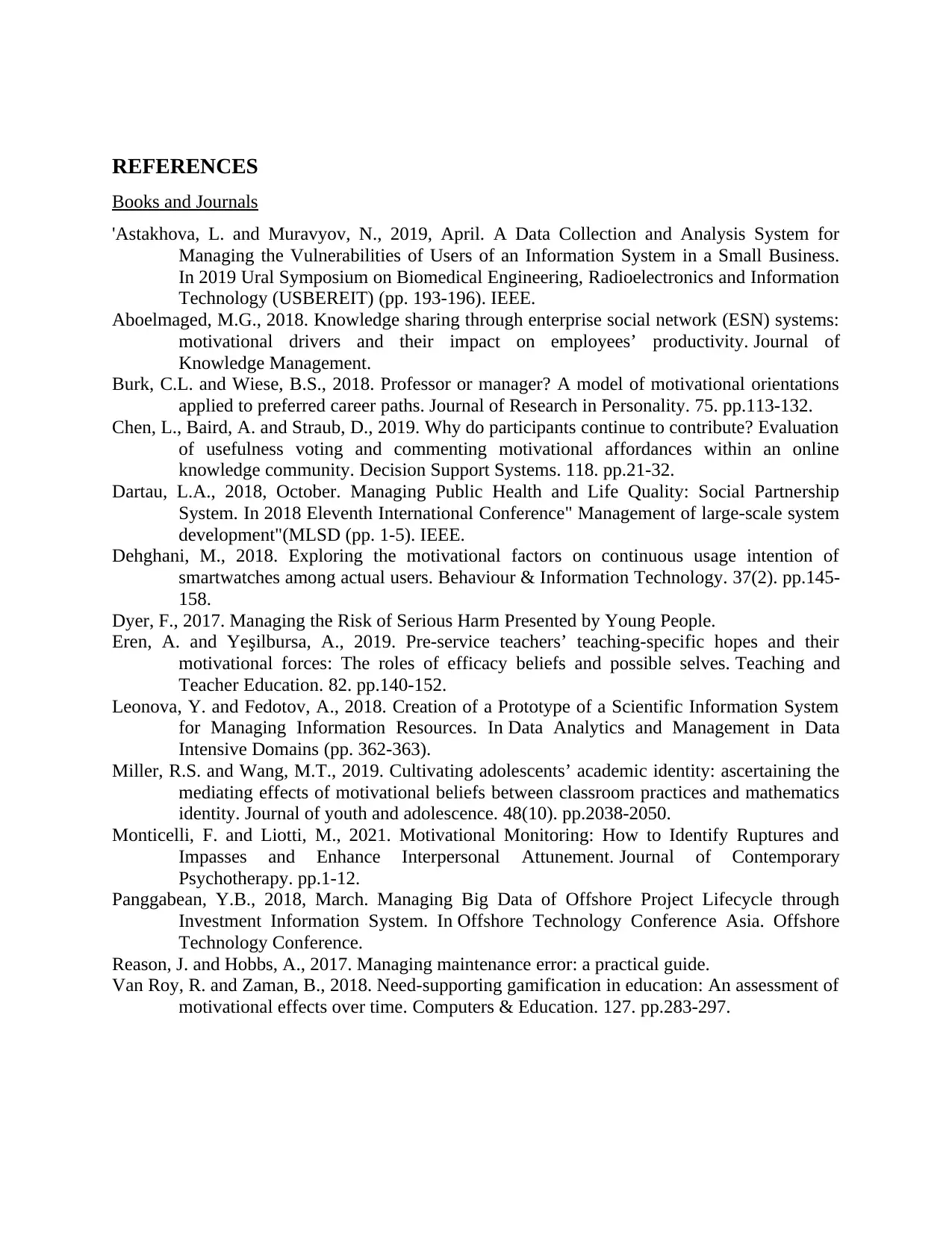
REFERENCES
Books and Journals
'Astakhova, L. and Muravyov, N., 2019, April. A Data Collection and Analysis System for
Managing the Vulnerabilities of Users of an Information System in a Small Business.
In 2019 Ural Symposium on Biomedical Engineering, Radioelectronics and Information
Technology (USBEREIT) (pp. 193-196). IEEE.
Aboelmaged, M.G., 2018. Knowledge sharing through enterprise social network (ESN) systems:
motivational drivers and their impact on employees’ productivity. Journal of
Knowledge Management.
Burk, C.L. and Wiese, B.S., 2018. Professor or manager? A model of motivational orientations
applied to preferred career paths. Journal of Research in Personality. 75. pp.113-132.
Chen, L., Baird, A. and Straub, D., 2019. Why do participants continue to contribute? Evaluation
of usefulness voting and commenting motivational affordances within an online
knowledge community. Decision Support Systems. 118. pp.21-32.
Dartau, L.A., 2018, October. Managing Public Health and Life Quality: Social Partnership
System. In 2018 Eleventh International Conference" Management of large-scale system
development"(MLSD (pp. 1-5). IEEE.
Dehghani, M., 2018. Exploring the motivational factors on continuous usage intention of
smartwatches among actual users. Behaviour & Information Technology. 37(2). pp.145-
158.
Dyer, F., 2017. Managing the Risk of Serious Harm Presented by Young People.
Eren, A. and Yeşilbursa, A., 2019. Pre-service teachers’ teaching-specific hopes and their
motivational forces: The roles of efficacy beliefs and possible selves. Teaching and
Teacher Education. 82. pp.140-152.
Leonova, Y. and Fedotov, A., 2018. Creation of a Prototype of a Scientific Information System
for Managing Information Resources. In Data Analytics and Management in Data
Intensive Domains (pp. 362-363).
Miller, R.S. and Wang, M.T., 2019. Cultivating adolescents’ academic identity: ascertaining the
mediating effects of motivational beliefs between classroom practices and mathematics
identity. Journal of youth and adolescence. 48(10). pp.2038-2050.
Monticelli, F. and Liotti, M., 2021. Motivational Monitoring: How to Identify Ruptures and
Impasses and Enhance Interpersonal Attunement. Journal of Contemporary
Psychotherapy. pp.1-12.
Panggabean, Y.B., 2018, March. Managing Big Data of Offshore Project Lifecycle through
Investment Information System. In Offshore Technology Conference Asia. Offshore
Technology Conference.
Reason, J. and Hobbs, A., 2017. Managing maintenance error: a practical guide.
Van Roy, R. and Zaman, B., 2018. Need-supporting gamification in education: An assessment of
motivational effects over time. Computers & Education. 127. pp.283-297.
Books and Journals
'Astakhova, L. and Muravyov, N., 2019, April. A Data Collection and Analysis System for
Managing the Vulnerabilities of Users of an Information System in a Small Business.
In 2019 Ural Symposium on Biomedical Engineering, Radioelectronics and Information
Technology (USBEREIT) (pp. 193-196). IEEE.
Aboelmaged, M.G., 2018. Knowledge sharing through enterprise social network (ESN) systems:
motivational drivers and their impact on employees’ productivity. Journal of
Knowledge Management.
Burk, C.L. and Wiese, B.S., 2018. Professor or manager? A model of motivational orientations
applied to preferred career paths. Journal of Research in Personality. 75. pp.113-132.
Chen, L., Baird, A. and Straub, D., 2019. Why do participants continue to contribute? Evaluation
of usefulness voting and commenting motivational affordances within an online
knowledge community. Decision Support Systems. 118. pp.21-32.
Dartau, L.A., 2018, October. Managing Public Health and Life Quality: Social Partnership
System. In 2018 Eleventh International Conference" Management of large-scale system
development"(MLSD (pp. 1-5). IEEE.
Dehghani, M., 2018. Exploring the motivational factors on continuous usage intention of
smartwatches among actual users. Behaviour & Information Technology. 37(2). pp.145-
158.
Dyer, F., 2017. Managing the Risk of Serious Harm Presented by Young People.
Eren, A. and Yeşilbursa, A., 2019. Pre-service teachers’ teaching-specific hopes and their
motivational forces: The roles of efficacy beliefs and possible selves. Teaching and
Teacher Education. 82. pp.140-152.
Leonova, Y. and Fedotov, A., 2018. Creation of a Prototype of a Scientific Information System
for Managing Information Resources. In Data Analytics and Management in Data
Intensive Domains (pp. 362-363).
Miller, R.S. and Wang, M.T., 2019. Cultivating adolescents’ academic identity: ascertaining the
mediating effects of motivational beliefs between classroom practices and mathematics
identity. Journal of youth and adolescence. 48(10). pp.2038-2050.
Monticelli, F. and Liotti, M., 2021. Motivational Monitoring: How to Identify Ruptures and
Impasses and Enhance Interpersonal Attunement. Journal of Contemporary
Psychotherapy. pp.1-12.
Panggabean, Y.B., 2018, March. Managing Big Data of Offshore Project Lifecycle through
Investment Information System. In Offshore Technology Conference Asia. Offshore
Technology Conference.
Reason, J. and Hobbs, A., 2017. Managing maintenance error: a practical guide.
Van Roy, R. and Zaman, B., 2018. Need-supporting gamification in education: An assessment of
motivational effects over time. Computers & Education. 127. pp.283-297.
Paraphrase This Document
Need a fresh take? Get an instant paraphrase of this document with our AI Paraphraser

1 out of 8
Related Documents
Your All-in-One AI-Powered Toolkit for Academic Success.
+13062052269
info@desklib.com
Available 24*7 on WhatsApp / Email
![[object Object]](/_next/static/media/star-bottom.7253800d.svg)
Unlock your academic potential
Copyright © 2020–2025 A2Z Services. All Rights Reserved. Developed and managed by ZUCOL.


